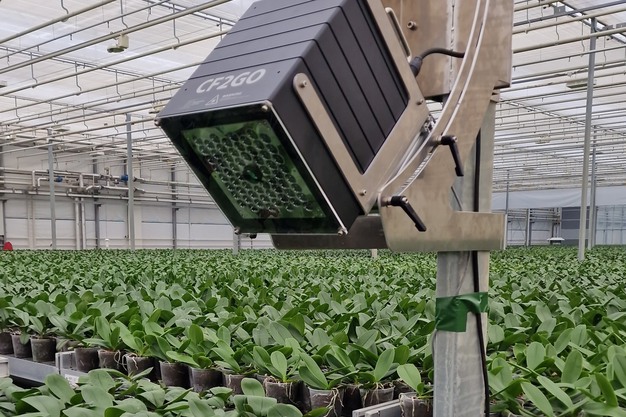The first three growers have started measuring photosynthesis efficiency every minute at more than 1,000 samples per second. They are doing so with a new type of photosynthesis efficiency sensor, from PhenoVation. Vincent Jalink gives an update.
"Over the past year, we have received many requests for a sensor that can measure greenhouse photosynthesis efficiency. Although we introduced a similar solution in 2013 with the CropObserver, the market was not ready for this innovation then."
But now things are different, he observes. Six prototypes of the new sensor, CF2GO, have been developed. Three of them are already in use by customers selected by PhenoVation. "These customers have experience with the CropObserver or already have experience with other photosynthesis efficiency sensors from other suppliers."
Without a license, the CF2GO can be integrated into any climate computer or decision platform. "The main difference with the CropObserver is that this new system will be fully integrated into Ledgnd's online platform MyLedgnd. When the CropObserver was introduced, we had to interpret the data ourselves. This worked but was difficult to scale and difficult to automate. Now, by focusing more on data modeling and automating recurring patterns, the product becomes easier to integrate and the system can take over specific tasks from the grower, such as fencing."
The sensor can be used stationary or on a moving mechanism such as a spray boom, to which it can be mounted. The sensor is 30% cheaper than its predecessor, the CropObserver.

CAM plants
Among other things, Vincent sees opportunities for measuring photosynthesis efficiency in CAM plants. In growing potted plants, Vincent sees the fastest Return on Investment. "Here we can ensure higher production, as growers have less fear of tipburn or discoloration at higher light intensities."
The sensor can be used to measure at CAM plants when a CAM plant is no longer absorbing CO2 during the day. "This is a challenge with other sensors that often work with clips and can only measure a small part of the plant. With the CF2GO, we can measure photosynthesis efficiency up to 100 centimeters from the crop, without physical contact. As a result, the system offers not only more flexibility but also a much more complete picture of what is happening in the greenhouse."
DLI
In addition, the CF2GO offers the ability to accurately determine the Daylight Integral (DLI) of plants. "By measuring photosynthesis efficiency in real-time, we can determine exactly when a plant is damaged by too high a light intensity at a given time. We can also see if the total amount of light per day (the DLI) is too high, which can lead to light stress and ultimately plant damage. These insights help growers to intervene quickly and create the ideal light conditions."
PhenoVation's new system can be applied in both illuminated and unlit cultivation. Especially in unexposed cultivation, light fluctuations in spring and autumn are sometimes so great that there is a risk of overexposure, Vincent knows. "For example, after four dark days, a sudden sunny day can provide too much light for the plant. In illuminated cultivation, this system can help deploy LED lighting as efficiently as possible, so that the DLI is achieved with as little LED light and as much sunlight as possible."
Automatic screening
Vincent knows that there is still much to learn about using the sensors, but he points out that previous experience has already shown that automatic screening is "definitely feasible. "That is why we will start automatic screens at an orchid grower in January so that the plants never receive too much and never too little light."
When using sensor data for screen decisions, the grower only has to set the desired DLI, Vincent explains. "CF2GO ensures that the plant receives the exact amount of light it needs. Sometimes this can be slightly below the set DLI, but sometimes above it if the plant feels 'happy', which we can monitor with real-time measurements of Fv/Fm, ETR, TFM and NPQ(t). This four-stage analysis shows us exactly when the plant is getting too much or too little light."
No AI
PhenoVation's system measures true plant health parameters. "No AI is used to find a correlation with photosynthesis. We really measure the efficiency of photosynthesis. Of course, we do use certain models and algorithms to find patterns, but we want to keep everything as close as possible to actually measuring plant health."
Tests in other crops, such as tomato and pepper, will follow in March.
For more information:
Vincent Jalink
PhenoVation
[email protected]
www.phenovation.com
LinkedIn
